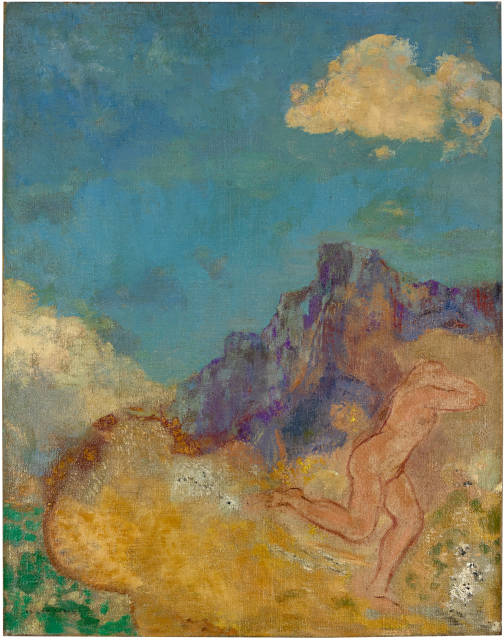- EN
Log in
- Live Auctions
- Online Only
- Past auctions
- Gallery
- Art Dealing
- Publishing
- Kornfeld today
- The Story of Kornfeld
- Information



Bordeaux 1840 - 1916 Paris
1910
Oil on canvas
65.5x51 cm
Signed "ODILON REDON" by the artist lower left
Alec Wildenstein, Odilon Redon, Catalogue raisonné de l'œuvre peint et dessiné, vol. 2, Paris 1994, no. 780
Auction Duveen, New York, 30 April-1 May 1952, lot 254
Fritz and Peter Nathan Gallery, Zurich, probably acquired there from
Private collection, Bern
Private collection Switzerland
Galerie Koller, Zurich, 1 July 2022, lot 3217, acquired there from
Private collection Switzerland
Klaus Berger, Odilon Redon, Fantasy and Colour, Cologne 1964, no. 79
Paris 1923, Galerie Druet, Exposition Odilon Redon, cat. no. 29 (label on verso)
Berne 1958, Kunsthalle, Odilon Redon, cat. no. 189
On the original chassis. Individual tear nail holes in the corners. In very good condition
As a reaction to the decorative theories of Maurice Denis and the Nabis as well as the Neo-Impressionists, Odilon Redon began to emancipate himself from classical Symbolism. He was a lifelong individualist who exhibited with the Impressionists and Symbolists, but never felt part of a group and instead absorbed various influences in order to develop his own visual language. The treatment of colour became his main concern, and the motifs interested him above all in terms of the possibilities they offered him to pursue his fascination with chromatic experiments. The depth of the iridescent mists of colour in his multi-layered paintings is astonishing.
The painting offered here dates from Redon's second or late creative period and is characterised by its highly mysterious expression. A naked female figure with long blonde hair is running down a slope in fright, covering her ears with her hands. However, the cause of the panicked reaction is not clear to the viewer. Redon is never interested in telling a story, but rather in capturing a moment. He often omits parts of the classic narration in order to focus on emotions and the unfathomable. Although Redon's multi-layered images often originate from the canon of ancient stories, they always blossom in his personally coloured world of ideas. "La fuite (the escape)" evokes associations with the escapes of the nymphs Daphne and Lotis or the Pleiades - but Redon simply omits the pursuers Apollo, Priapus or Orion. He thus focuses the storyline entirely on the emotional level of the pursued woman, leaving her and her fate literally alone in the dense fog of colour surrounding her.
As is so often the case, the painter develops the painting out of the painted areas of colour, which are never classically constructed, but rather have their origin in an inner intuition. The colours intermingle in a cloud-like manner, making the oil paintings reminiscent of the pastel chalks that Redon liked to use for his works on paper. An impressive composition that exemplifies Redon's significance for the Expressionist and Surrealist artists who followed.
1910
Öl auf Leinwand
65,5x51 cm
Unten links vom Künstler signiert "ODILON REDON"
Alec Wildenstein, Odilon Redon, Catalogue raisonné de l'œuvre peint et dessiné, Band 2, Paris 1994,
Auktion Duveen, New York, 30. April–1. Mai 1952, Los 254
Galerie Fritz und Peter Nathan, Zürich, wohl dort erworben von
Privatsammlung Bern
Privatsammlung Schweiz
Galerie Koller, Zürich, 1. Juli 2022, Los 3217, dort erworben von
Privatsammlung Schweiz
Klaus Berger, Odilon Redon, Phantasie und Farbe, Köln 1964,
Paris 1923, Galerie Druet, Exposition Odilon Redon,
Bern 1958, Kunsthalle, Odilon Redon,
Auf dem originalen Chassis. Einzelne Reissnägellöcher in den Ecken. In sehr guter Erhaltung
Als Reaktion auf die dekorativen Theorien von Maurice Denis und der Nabis sowie der Neoimpressionisten begann sich Odilon Redon vom klassischen Symbolismus zu emanzipieren. Er war ein lebenslanger Individualist, der zwar mit den Impressionisten und Symbolisten ausstellte, sich aber nie zu einer Gruppe zugehörig fühlte und stattdessen verschiedene Einflüsse in sich aufnahm, um seine eigene Bildsprache zu entwickeln. Die Behandlung der Farbe wurde zu seinem Hauptanliegen, und die Motive interessierten ihn vor allem im Hinblick auf die Möglichkeiten, die sie ihm boten, um seiner Faszination für chromatische Experimente nachzugehen. So verblüffen seine vielschichtigen Bilder gerade auch durch die Tiefe der irisierenden Farbnebel.
Das hier angebotene Gemälde stammt aus der zweiten bzw. späten Schaffenszeit von Redon und besticht durch seinen sehr geheimnisvollen Ausdruck. Eine nackte Frauengestalt mit langen blonden Haaren läuft vor Schreck einen Abhang hinunter und hält sich dabei mit den Händen die Ohren zu. Den Betrachtenden erschliesst sich die Ursache der panischen Reaktion jedoch nicht. Redon geht es nie um das Erzählen einer Geschichte, sondern vielmehr um das Einfangen eines Moments. So lässt er oft Teile der klassischen Narration weg, um den Fokus auf Emotionen und das Unergründliche zu legen. Die vielschichtigen Bilder Redons entstammten zwar oft dem Kanon antiker Geschichten, erblühen aber stets in seiner persönlich gefärbten Ideenwelt. "La fuite (die Flucht)" lässt Assoziationen an die Fluchten der Nymphen Daphne und Lotis oder der Plejaden erinnern – Redon lässt jedoch die Verfolger Apollon, Priapos oder Orion einfach weg. Er fokussiert so den Handlungsstrang ganz auf die Gefühlsebene der verfolgten Frau, er lässt sie und ihr Schicksal förmlich alleine im dichten, sie umgebenden Farbnebel.
Wie so oft entwickelt der Maler auch hier das Gemälde aus den gemalten Farbflächen heraus, die jedoch nie klassisch aufgebaut sind, sondern ihren Ursprung vielmehr in einer inneren Intuition haben. Die Farben vermischen sich in wolkenartiger Weise, die Ölgemälde erinnern so an Pastellkreiden, die Redon gerne für seine Papierarbeiten verwendete. Eine eindrückliche Komposition, die Redons Bedeutung für die nachkommenden Kunstschaffenden des Expressionismus und des Surrealismus exemplarisch aufzeigt.
| Switzerland | CHF | 170 |
| Europe | CHF | 270 |
| Overseas | CHF | 360 |




